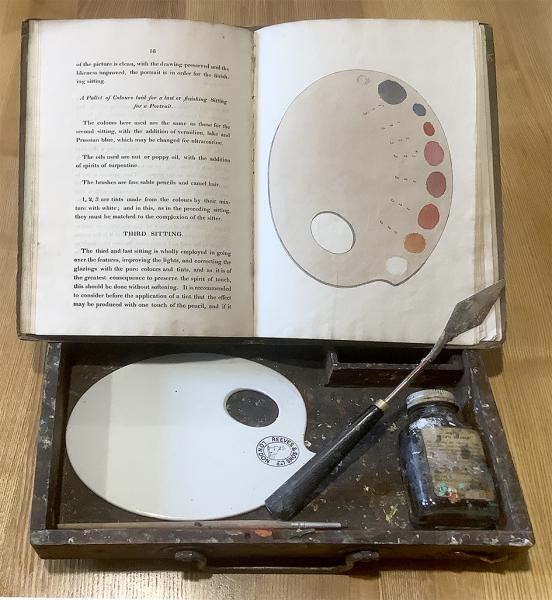The Drawing Book Project

For over 30 years Tony Fothergill of Ken Spelman Books in York has been working on a vast bibliography of United Kingdom published drawing books, from the 16th century to 1900.
The germ of this idea came from some 'rather good lunches' during the ABA Park Lane Book Fairs between Tony Fothergill and Priscilla Wrightson, who edited probably the first catalogue devoted to this area, issued by Bernard Weinreb in 1978. Spelman’s started putting together their own collection, now at the Getty Institute, and specialised in the area ever since, filling gaps in institutions worldwide.
The list started as a reference tool rather than a bibliography; Spelman’s own price-guide to items sold over the past 50 years, which was added to each year, and put into a binding. But Tony always had bigger ideas, saying “at the back of my mind there was always a bibliography lurking there. It was relatively easy in the pre-internet days, combing printed catalogues and library holdings, but the explosion of material brought about by online databases, kept moving the achievable horizon ever further away. Also, I wanted it to include the unrecorded, mis-identified, and largely overlooked material published as drawing aids, but often little more than suites of plates, compiled from whatever the publisher had to hand and could get out into the marketplace. This is a never-ending path, with many twists and turns. There are pieces that don’t fit, but very slowly a jigsaw comes together.”
The bibliography includes instruction manuals on all forms of painting, drawing, engraving, colour theory, perspective, anatomy for artists and more, and currently runs to 1090 pages, making it probably the largest unpublished reference database of these books.
When the project was first started – before the internet became available in every home and on every hand-held device across the world - it was thought impossible to gain information on the huge range of anonymous and ephemeral material published to aid students in drawing and painting. Progress on the project was slow to begin with and slowed even further with the arrival of Tony’s four children, leaving little time to devote to it.
“The 2020 lock-down allowed time to rekindle the idea, the internet provided the means, and a long chat with Priscilla gave me the kick-start I needed!” says Tony. The bibliography remains a work in progress but is updated regularly.
The bibliography includes records of institutional holdings of UK published drawing books, suites of plates, ephemeral publications and the like. These are augmented with variants and additions which have appeared in commerce, in booksellers' catalogues over the last seventy years, as well as auction records. Entries to ESTC, the BM and other online resources are hyper-linked, so the entry automatically updates as libraries add further holdings or amend information. Where possible there are also links to images of the scarcer material.
It can be accessed alphabetically and includes full entries for every record. Short-entry lists have also been created for specific categories, including Flower Painting, Oil Painting, Engraving, Lithography, Anatomy, Colour Theory, Perspective, Picturesque, and Maritime and Naval. You can also view lists of non-London printings, Women authors and books for women, and Drawing Masters.
We recently spoke with Tony Fothergill to ask about his favourite items from the list:
'I think my favourites are those that require a lot of research to reveal themselves. I have just been working on a copy of PARKINSON, Thomas. Flower Painting Made Easy. c1751. A very rare work, recorded in a handful of copies, in coloured form. That part is easy - but this is uncoloured, and like another uncoloured copy in the Royal Library of the Netherlands, is made up with some duplicate plates - but different between the two copies. It appears that the publishers probably used whatever plates were left over from producing the hand-coloured copies,and bound them up. Individual hand-coloured plates may also have been sold separately, leaving them short of some numbers.
'In addition, this copy also belonged to a young, child prodigy and friend of Hester Piozzi, who may have used this copy as a guide to ornament her decorative manuscript, which was acquired in 1928 by the National Museum of Wales.
'Another item, recently sold to an institution, was a 19th century treatise on painting, with an accompanying paint box - unnoticed in a local auction - but which with research was found to have belonged to John Constable's closest friend.
So, in short, I enjoy anything that goes beyond straightforward collation!'
Access The Drawing Book Project here >
Contribute
If you’d like to contribute to this project, Tony welcomes details of rare or unusual items, especially suites of the 17th century 'drawing books' which mainly exist only in fragmentary parts, or single plates. Also ancillary material such as prospectuses, subscription announcements, trade-cards, adverts, hand-bills which relate to the books, drawing academies, and drawing masters. Manuscript material also helps build this picture.
Tony would like to thank all those who have been so supportive in sending in material, correcting and editing entries, and which in the spirit of the internet makes this a collaborative and free-to-all resource.
Tony remains an active buyer in this area. If you have items for sale you can reach him at kenspelmanbooks@gmail.com or write to
Ken Spelman Books Ltd
PO Box 807
York, YO1 0PF
